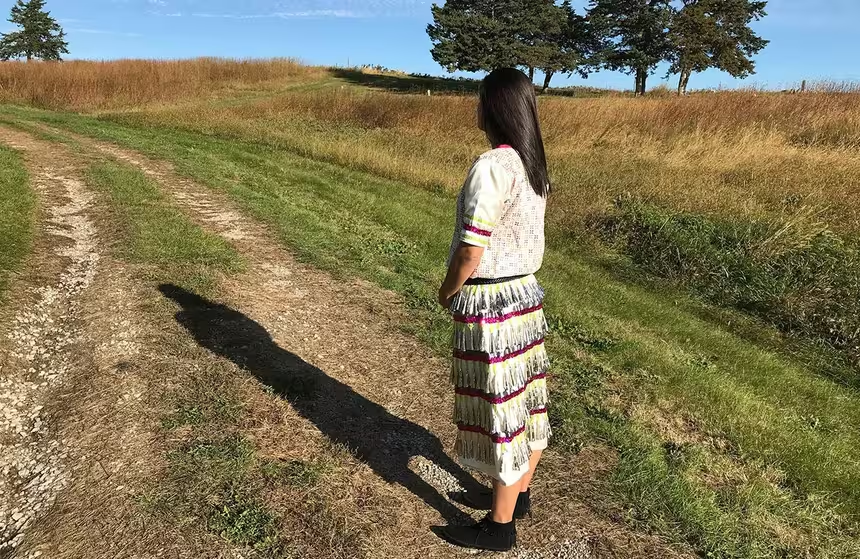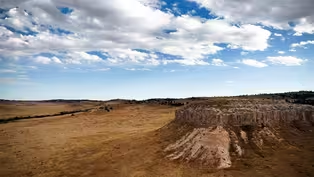
Brandon Bailey's Vision of the West
Clip: Season 16 Episode 4 | 5m 57sVideo has Closed Captions
Brandon Bailey is a Western and wildlife artist known for his old-school cowboy style paintings.
Brandon Bailey is a Western and wildlife artist known for his old-school cowboy style paintings. In 2019, he began incorporating Native American themes into his work and in 2021, he was inducted into the prestigious Cowboy Artists of America. He lives near Scotts Bluff National Monument, where the scenic landscape and rich history of the American West continue to inspire him.
Problems playing video? | Closed Captioning Feedback
Problems playing video? | Closed Captioning Feedback
Nebraska Stories is a local public television program presented by Nebraska Public Media

Brandon Bailey's Vision of the West
Clip: Season 16 Episode 4 | 5m 57sVideo has Closed Captions
Brandon Bailey is a Western and wildlife artist known for his old-school cowboy style paintings. In 2019, he began incorporating Native American themes into his work and in 2021, he was inducted into the prestigious Cowboy Artists of America. He lives near Scotts Bluff National Monument, where the scenic landscape and rich history of the American West continue to inspire him.
Problems playing video? | Closed Captioning Feedback
How to Watch Nebraska Stories
Nebraska Stories is available to stream on pbs.org and the free PBS App, available on iPhone, Apple TV, Android TV, Android smartphones, Amazon Fire TV, Amazon Fire Tablet, Roku, Samsung Smart TV, and Vizio.

Do you have a Nebraska Story?
Do you have a story that you think should be told on Nebraska Stories? Send an email with your story idea, your name, your city and an email address and/or phone number to nebraskastories@nebraskapublicmedia.org. Or, click the link below and submit your information on nebraskastories.org.Providing Support for PBS.org
Learn Moreabout PBS online sponsorship(gentle music) (gentle music) -[Narrator] Brandon Bailey credits fate with bringing him to the western edge of Nebraska's panhandle.
(gentle music) He and wife, Priscilla, and a host of critters live on a ranch nestled in the rolling hills and canyons near the Wildcat Hills.
(gentle music) The Wyoming native came to Nebraska to study art education and ended up dropping out to pursue art instead.
(gentle music) -[Brandon] Self-taught is an interesting concept because I would say more self-motivated than anything.
Trying to find artists that you admire and look up to, and that's where I started.
Some of those artists that took me under their wing and kind of showed me the ropes, someone would give me a pointer, "Hey, why don't you try this?"
And I would just start doing those little things, and then that just kept expanding upon the language of art for me.
(brush scraping) -[Narrator] Bailey began drawing at an early age as a way to document experiences.
(brush scratching) And now, before he spends time in the studio, Bailey takes his brushes into the field.
(brush scratching) -[Brandon] Seeing old buffalo wallows, you know, and walking in the same footsteps that the Kiowa, the Lakota, and even the Stone Age prehistoric peoples would have walked.
You're seeing all that history written in the land.
I consider the hiking aspect of it is just as much a part of my painting as it is the actual painting itself.
Going out and seeing how the grasses are at two in the afternoon on a sunny day, it's almost like you're painting in your head as you're walking along.
I can capture different times of day and sometimes it doesn't translate the same way in my photography.
So like a shadow will be kind of darkened, whereas in plain air, if you really observe something, you'll see the colors that are in that shadow.
And so these are color studies, so you're getting the colors of that environment and then you take that into the studio.
(brush scratching) -[Narrator] His latest piece depicts native wolf scouts.
His process is meticulous.
He researches key details for historical accuracy, from tribal beating patterns to the feathers that might have been worn.
He uses photographs, either historical or modern recreations as a reference.
The weather, time of day, the interplay of light and shadows are all used to recreate the moment as it might have unfolded.
(gentle music) In the early part of his career, Bailey found success painting wildlife, landscapes and cowboys.
But as a member of the Ottawa and Chippewa nations, he was hesitant to explore his heritage in his work.
-[BrandonÑ I didn't wanna paint my tribe because I didn't grow up around it.
So growing up around the West, I was more interested in the Plains Indians and the tribes of this area.
I kicked it down the road, I didn't want to paint it because I knew the respect and the reverence that it took to portray that correctly.
(gentle music) -[Narrator] A few years ago, that all changed.
-[Brandon] I kind of went on a photo shoot for the first time and started getting the reference of Native Americans dressed in different tribal outfits and you know, whether it was Blackfeet, tribal war shirts, or headdresses to Lakota and I just kind of started painting it, and then from there it became an obsession of how much can I learn about cultures of the plains.
(gentle music) I don't speak for all native people either, that this is just my experience with painting what I'm painting, and this is the contribution I can give, but it's not everybody's story.
(gentle music) My experience as someone that's half white and half native, you know, that's what I'm bringing to it.
But I've been finding my native roots through the painting and trying to discover that side of me.
(gentle music) -[Narrator] In 2019, the Cowboy Artists of America invited Bailey to join their exclusive ranks.
-[Brandon] We're portraying the truth of the West, I guess that's the main mission behind the CA.
(gentle music) I'm still speechless about the whole thing.
I mean, I was in tears when I got invited in.
It's one of those deals where I know there's nothing more prestigious I can do in my career.
(gentle music) -[Narrator] A few years ago, Bailey began sculpting as well.
[Brandon] And it just came natural to me.
With sculpting, I actually have more fun doing sculpting than I do painting because it's like you have something 3D to work with.
And so I did the bison, you know this big, and now it's in downtown Cheyenne.
And so the same as with this pronghorn antelope, I did the Marquette, somebody saw it and now wants to do a half life size.
(gentle music) -[Narrator] Still, even as Bailey's sculptures gain recognition, painting remains his true passion.
(gentle music) -[Brandon] There's no such thing as making it in this business.
You just get up every day and try to get better.
It's one of those pursuits that, you know, when I still have a painting on my easel at the end of the road in my life, I'll probably still be trying to learn how to paint.
And I think that's what makes it fun, is you're never gonna figure it out but you know, you'll keep trying.
(gentle music) (gentle music) (gentle music) (gentle music) (gentle music)
Signal Butte Hidden In Plain Sight
Video has Closed Captions
Preview: S16 Ep4 | 2m 40s | Discover one of Nebraska's hidden archaeological gems. (2m 40s)
Providing Support for PBS.org
Learn Moreabout PBS online sponsorshipSupport for PBS provided by:
Nebraska Stories is a local public television program presented by Nebraska Public Media
















